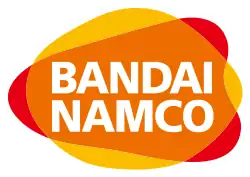Bandai Namco Entertainment
Bandai Namco Entertainment Inc.[lower-alpha 1] is a Japanese multinational video game developer and publisher, headquartered in Minato-ku, Tokyo. Its international branches, Bandai Namco Entertainment America and Bandai Namco Entertainment Europe, are respectively headquartered in Santa Clara, California and Lyon, France. It is a wholly owned subsidiary of Bandai Namco Holdings.
 | |
 BNEI's headquarters in Tokyo, Japan | |
Native name | 株式会社バンダイナムコエンターテインメント |
|---|---|
Romanized name | Kabushiki gaisha Bandai Namuko Entāteinmento |
| Formerly |
|
| Type | Kabushiki gaisha Subsidiary |
| Industry | Video games |
| Predecessor | Namco |
| Founded | 31 March 2006[1][2] |
| Headquarters | Minato, Tokyo, Japan |
Area served | Worldwide |
Key people | Satoshi Oshita (President and CEO) |
| Products | List of Bandai Namco video games |
| Revenue | |
Number of employees | 710 (2018) |
| Parent | Bandai Namco Holdings |
| Subsidiaries | B.B. Studio Bandai Namco Studios Bandai Namco Online Bandai Namco Network Services Bandai Namco Rights Marketing Bandai Namco Rights Marketing Bandai Namco Sevens Bandai Namco Research Inc BXD Inc. D3 Publisher Reflector Entertainment Vibe Inc. |
| Website | www |
Bandai Namco Entertainment was formed on 31 March 2006, following a corporate merge between Namco and Bandai on 29 September of the previous year. Originally known as Namco Bandai Games, they merged Bandai Games and Namco Networks in January to create a North American division, Namco Bandai Games America. Namco Bandai Games absorbed Banpresto's video game division in 2008 and dissolving Bandai Networks in 2009. Development operations were spun-off into a new company in 2012, Namco Bandai Studios (now Bandai Namco Studios), to help create faster development time and tighter cohesion between development teams. Namco Bandai Games was renamed Bandai Namco Games in 2014 and again to Bandai Namco Entertainment a year later.
Bandai Namco Entertainment owns several multi-million video game franchises, including Gundam, Pac-Man, Tekken, Soulcalibur, Tales, Ace Combat, Taiko no Tatsujin, The Idolmaster and Dark Souls. As of March 2020, it is the third-largest game company in Japan in terms of revenue and market capitalization, after Sony Interactive Entertainment and Nintendo, ahead of Square Enix, Konami, and Sega.[3] The company also owns the licenses to several Japanese media franchises such as Dragon Ball, One Piece, Sword Art Online and Naruto. It is the core publishing and development area of the Bandai Namco Group's "Content Strategic Business Unit" (Content SBU),[4] and the main video game branch of Bandai Namco Holdings.
History
In February 2005, in the wake of their 50th anniversary, Namco announced their intent to merge with Bandai to form Bandai Namco Holdings. The merge was finalized on September 25, creating the third-largest video game publisher in Japan by revenue.[5] Bandai purchased Namco for US$1.7 billion, with Namco receiving 43 percent of shares and Bandai receiving the other 57 percent. Both companies in a joint statement cited Japan's decreasing birth rates and advancements in technology as the reason for the merge, and to increase their relevance to newer audiences. Both companies worked independently under the newly formed Bandai Namco Holdings until March 31, 2006, when their video game operations were merged to form Namco Bandai Games.[1][2][6] Earlier on 26 January, Namco Hometek and Bandai Games merged to form Namco Bandai Games America, the North American division.[7][8]
On 1 April 2008, Banpresto's video game operations were absorbed by Namco Bandai Games.[9] On 1 April 2009, Bandai Networks, Namco Bandai's mobile phone business, was dissolved and absorbed into Namco Bandai Games.[10]
Just prior to the release of Afro Samurai at the end of 2008, the company announced the Surge publishing label.[11] The new label was an attempt at creating a separate identity for the company, aimed at a Western audience desiring more mature themes in-game content.[12] Following Afro, early press materials indicated that Dead to Rights: Retribution and Splatterhouse would also be released under the Surge label, but neither game ultimately did; both were released with a retro Namco label instead to reflect the series' legacy.
In 2010, Namco Bandai Games entered the Guinness World Records as the company that released the most TV commercials for the same product, a Nintendo DS game called Solatorobo: Red the Hunter. They created 100 versions of the ad as the game consists of 100 chapters.[13]
In early 2011, Namco Networks was absorbed into Namco Bandai Games America, effectively consolidating Namco Bandai's American console, handheld, and mobile video game development operations.[14]
On 2 April 2012, Namco Bandai Games spun off its development operations into a new company called Namco Bandai Studios. The new company was spurred by Namco Bandai's interest in faster development times and tighter cohesion between disparate development teams. It comprises approximately 1,000 employees, who were already part of Namco Bandai.[15]
In March 2013, Namco Bandai Games established two new game studios. The first, Namco Bandai Studios Singapore, is Namco Bandai's "leading development center" in Asia and develops game content for the Asia Pacific market. The second studio, Namco Bandai Studios Vancouver, works on online social games and game content development for North America and Europe, and is part of the Center for Digital Media (CDM).[16] In July 2013, Namco Bandai Partners (NBP), which used to oversee the PAL distribution network since September 2012, merged with Namco Bandai Games Europe (NBGE) in order to push distribution and publishing into one entity, Namco Bandai Games Europe (NBGE).[17]
In 2014, Namco Bandai Games and Namco Bandai Studios became Bandai Namco Games and Bandai Namco Studios, respectively. The change unified the brand internationally in order to increase the "value" and "appeal" of the name.[18] The full company name was changed to Bandai Namco Entertainment on 1 April 2015.[19]
On 1 April 2018, the amusement machine business division of Bandai Namco Entertainment was transferred over to sister company Bandai Namco Amusement.[20][21]
In September 2020, Bandai Namco Entertainment Europe acquired Canadian video game developer Reflector Entertainment.[22]
Corporate structure
Bandai Namco Entertainment was originally headquartered in Shinagawa, Tokyo, moving their operations to Minato-ku, Tokyo in February 2016. The North American and European divisions respectively in Santa Clara, California as Bandai Namco Entertainment America, and in Lyon, France as Bandai Namco Entertainment Europe. Divisions have also been established in mainland China, Hong Kong and Taiwan. Bandai Namco Oceania, originally known as Sega Ozisoft and later Infogrames Australia, oversees the publishing of video games for Oceania (Australia and New Zealand), is the country's lead distributor of games from Square Enix Europe, NIS America and Codemasters. Bandai Namco Entertainment is the core development division of the Bandai Namco Group's "Content Strategic Business Unit" (Content SBU), and the main video game branch of Bandai Namco Holdings.
Software development and subsidiaries
The core video game development studio of Bandai Namco Entertainment is Bandai Namco Studios, established in April 2012 as a separate company — Bandai Namco Studios creates video games for home consoles, handheld systems, mobile devices and arcade hardware, while Bandai Namco Entertainment handles the managing, marketing and publishing of these products.[15] Bandai Namco Studios also produces music and videos based on its properties and has development studios in the European Union, Canada, Malaysia, Thailand, Singapore, Taiwan, and the United Kingdom.[16] Bandai Namco Online is a subsidiary responsible for online in Bandai Namco Studios games, and also develop games focusing on online. B.B. Studio was formed in April 2011 from a merge between Banpresto and Bandai Entertainment Company (BEC), handling the development of the Super Robot Wars franchise and other video games based on Japanese licenses.
Notes
References
- Karlin, David (1 November 2006). "Bandai and Namco Finalize Merger Details". 1UP.com. Archived from the original on 12 March 2014. Retrieved 21 November 2020.
With around 1800 employees, Bandai Namco Games will be established on March 31st, 2006.
- "Reorganization of the Japanese Operations of the BANDAI NAMCO Group" (PDF). 11 January 2006. Archived (PDF) from the original on 9 February 2021. Retrieved 5 May 2020.
On March 31, 2006 it will establish a new Group company under the name of NAMCO BANDAI Games Inc.
- "Top 25 gaming companies". Newzoo.com. 2015. Archived from the original on 5 January 2016. Retrieved 16 September 2015.
- "Strategic Business Units". Bandai Namco. Archived from the original on 30 April 2014. Retrieved 9 February 2020.
- Feldman, Curt (13 December 2005). "Bandai, Namco to merge". GameSpot. Archived from the original on 8 April 2014. Retrieved 9 February 2020.
- "株式会社バンダイナムコホールディングス 2005年度事業報告書" (PDF). Bandai Namco Holdings. 2006. Archived from the original (PDF) on 5 September 2015. Retrieved 6 August 2017.
- Adams, David. "Namco, Bandai Complete North American Merger". IGN. Retrieved 2 February 2014.
- "Namco and Bandai complete merger in North America". GameSpy. 4 January 2006. Archived from the original on 26 January 2014. Retrieved 2 February 2014.
- Spencer (9 November 2007). "Banpresto absorbed by Namco Bandai". Silicon Era. Archived from the original on 23 February 2014. Retrieved 2 February 2014.
- "KatanaXtreme.com – Namco Bandai Games Inc. to Take Over Bandai Networks Co., Ltd". Archived from the original on 23 January 2009. Retrieved 10 December 2008.
- McWhertor, Michael. "Namco Bandai Needs Westerners, Plans "Surge"". Kotaku. Archived from the original on 26 December 2010. Retrieved 27 November 2010.
- Sheffield, Brandon. "Q&A: Namco Bandai's Iwai Talks Tricky Topics In Western Markets". Gamasutra. Archived from the original on 13 November 2010. Retrieved 27 November 2010.
- "Most TV commercials for the same product (8 hrs) – regional/Free-to-air". Guinness World Records. Archived from the original on 3 February 2014. Retrieved 2 February 2014.
- "Namco Bandai Games America/Namco Networks merger". Games Industry International. 5 August 2010. Archived from the original on 19 February 2014. Retrieved 9 February 2020.
- Gilbert, Ben (10 February 2012). "Namco spins off internal dev studios into 'Namco Bandai Studio'". Famitsu. Engadget. Archived from the original on 9 February 2021. Retrieved 9 February 2020.
- Romano, Sal (10 April 2013). "Namco Bandai opening Singapore and Vancouver studios". Gematsu. Archived from the original on 18 February 2014. Retrieved 2 February 2014.
- Long, Niel (1 July 2013). "Namco Bandai completes merger of publishing and distribution businesses". Edge Magazine. Archived from the original on 4 February 2014. Retrieved 2 February 2014.
- Goldfarb, Andrew. "Namco Bandai Changing Name to Bandai Namco". IGN. Archived from the original on 16 December 2019. Retrieved 2 February 2014.
- 2014-12-16, Bandai Namco Games changing name to Bandai Namco Entertainment Archived 13 October 2019 at the Wayback Machine, Gematsu
- "Notice Regarding Reorganization of Subsidiaries". Bandai Namco Holdings Inc. 9 February 2018. Archived from the original on 9 February 2021. Retrieved 21 November 2020.
- Corporate History Archived 9 February 2021 at the Wayback Machine, Bandai Namco Entertainment
- "Bandai Namco acquires Unknown 9 studio Reflector Entertainment". Gematsu. Archived from the original on 9 February 2021. Retrieved 18 September 2020.

